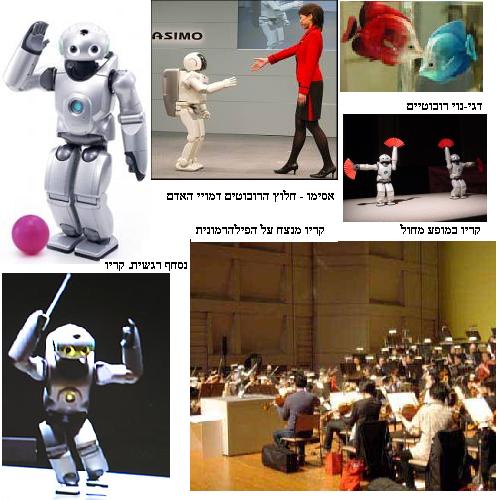Kryo, a 58 cm tall humanoid robot, met the advanced challenge: an exciting conducting of the Tokyo Philharmonic * (published in "Globes" on May 11-10, 2004 and reproduced on the Hidaan website with the permission of the author)
Michael Rosenberg

Direct link to this page: https://www.hayadan.org.il/rosenberg001.html
Sony's Qrio robot continues to amaze researchers in the robotics industry. After four robots of his type performed an impressive dance performance last December with refined and smooth movements, Kryo led the Tokyo Philharmonic Orchestra in the performance of Beethoven's Fifth Symphony. Kerio responded to the sounds of the orchestra while writing his musical commentary on the manner of the performance. Conducting Beethoven's fifth, which is a romantic work characterized by emotional drift at the level of tempo and dynamics (rate and volume) is one of the most complex challenges that have been put to a robot so far. Kryo, whose height does not exceed 58 cm, is undoubtedly the humanoid robot with the most advanced motor achievements. He was the first to overcome the sharp and fragmented movements that characterized the humanoid robots. The "robotic" movements were one of the barriers on the way to reducing reluctance and developing a friendlier attitude towards robots. Little Kryo manages to demonstrate fine motor skills with smooth and humane movements while maintaining balance. Its movement system reacts immediately to any environmental change or contact with it and it is endowed with the ability to recognize voices and conduct a friendly conversation with its operators.
Kryo's body is composed of magnesium parts and his movement system is still hydraulic, therefore he is considered a first generation robot. The next generation of human robots will be based on electro-active polymer technologies, which are plastic molecules that react to electrical charges. This technology is already applied in robotic ornamental fish that are recently sold in toy and pet stores.
The complete absence of robotic housekeepers and butlers is the most painful technological disappointment of the early XNUMXs. Sony's Kryo robot is the pioneer of social robots.
Krio is a so-called "social robot", it was specially developed with the aim of creating human interactions between it and its operators and to be used for company entertainment and as an entertainment element. To create a friendly impression, it responds with familiar facial expressions and movements so as not to discourage its users. On the other hand, he still maintains a robotic appearance as studies have shown that a human appearance beyond a certain point of resemblance becomes intimidating again. The development of humanoid robots is a frustrating field of research as a huge gap between expectations and development capabilities has been discovered. The complete absence of robotic housekeepers and butlers is the most painful technological disappointment of the early XNUMXs. While about twenty years ago it seemed that the XNUMXs would be filled with such robots, it was only a few years ago that a humanoid robot named Asimo managed to walk on two feet, and that too at a rate of one and a half kilometers per hour and with rather clumsy movements. Maintaining equilibrium in changing terrain conditions requires a huge number of algorithms to program such a robot. As research and development in the field progresses, it is revealed how complex and complicated daily human activity is. The programming of the elements that underlie human orientation in space, such as finding the distance to different objects or recognizing faces, turns out to be much more complex than they thought.
The development of humanoid robots is currently mainly concentrated in a unique department at the Massachusetts Institute of Technology (MIT). The Japanese are the spearhead in the field, mainly thanks to investments by commercial companies such as "Honda" and "Sony". The commercial applications of the human robots will not be manifested in the coming years but their potential is enormous. The challenge in developing a machine that functions as a human is no less than the challenge of conquering space. The task raises ethical questions as well as philosophical questions about the nature of human consciousness: is such a development possible? What is consciousness? What is desire? Will a robot ever be able to think in the meaning of Descartes' insight "I think therefore I exist"?
Most researchers in the field believe that beyond a certain point in the level of complexity of thought, consciousness appears as an epi-phenomenon (super-phenomenon or accompanying phenomenon) of that complexity. Therefore, just as the mind of a two-year-old child reaches such a level of ability that allows him to be aware of his existence, so too a computer with a sufficiently complex level of computation will develop such a consciousness.
In 1997, the "deep blue" computer managed to defeat the world chess champion Garry Kasparov, this achievement gave a huge boost towards the development of a thinking machine. However, it turns out that the development of logical thinking abilities and problem solving are not the pinnacle of human ability since the revelations of simple intuitions that every child is capable of - are more complex. Beating Kasparov in a game of chess is a much easier task than making soup for example, we are still far from developing a robot that knows how to season soup "to taste" and not according to pre-dictated data. Human intuitions are a function of our being social beings, the basis of self-consciousness is probably the ability to separate the self from the other. While the main focus of the field today is on computer science, biomechanics, artificial intelligence and materials research, in the coming years researchers will be forced to closely study the processes related to human social interaction. Thus, through the development of humanoid robots we learn to know ourselves as we have not known before.
For a collection of Michael Rosenberg's articles
Yadan dedicated to Asimov and his influence on the world of robotics for the film I, Robot
Knowledgeable in robotics and artificial intelligence
https://www.hayadan.org.il/BuildaGate4/general2/data_card.php?Cat=~~~924737746~~~177&SiteName=hayadan
